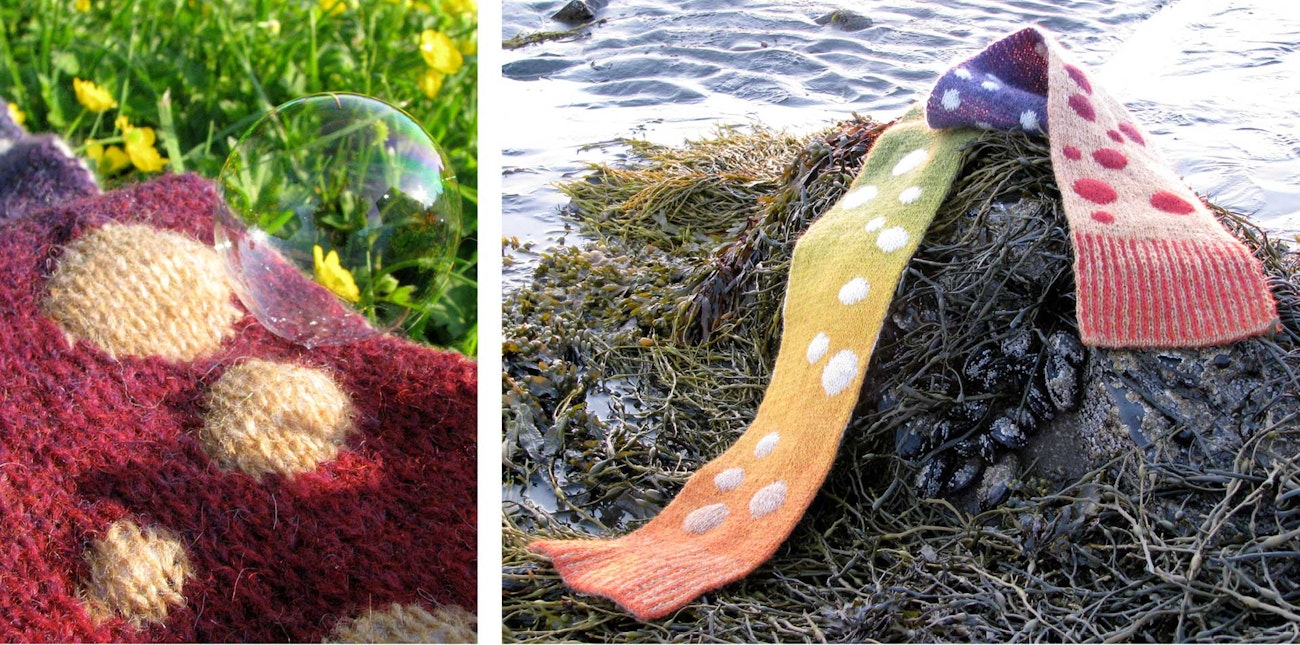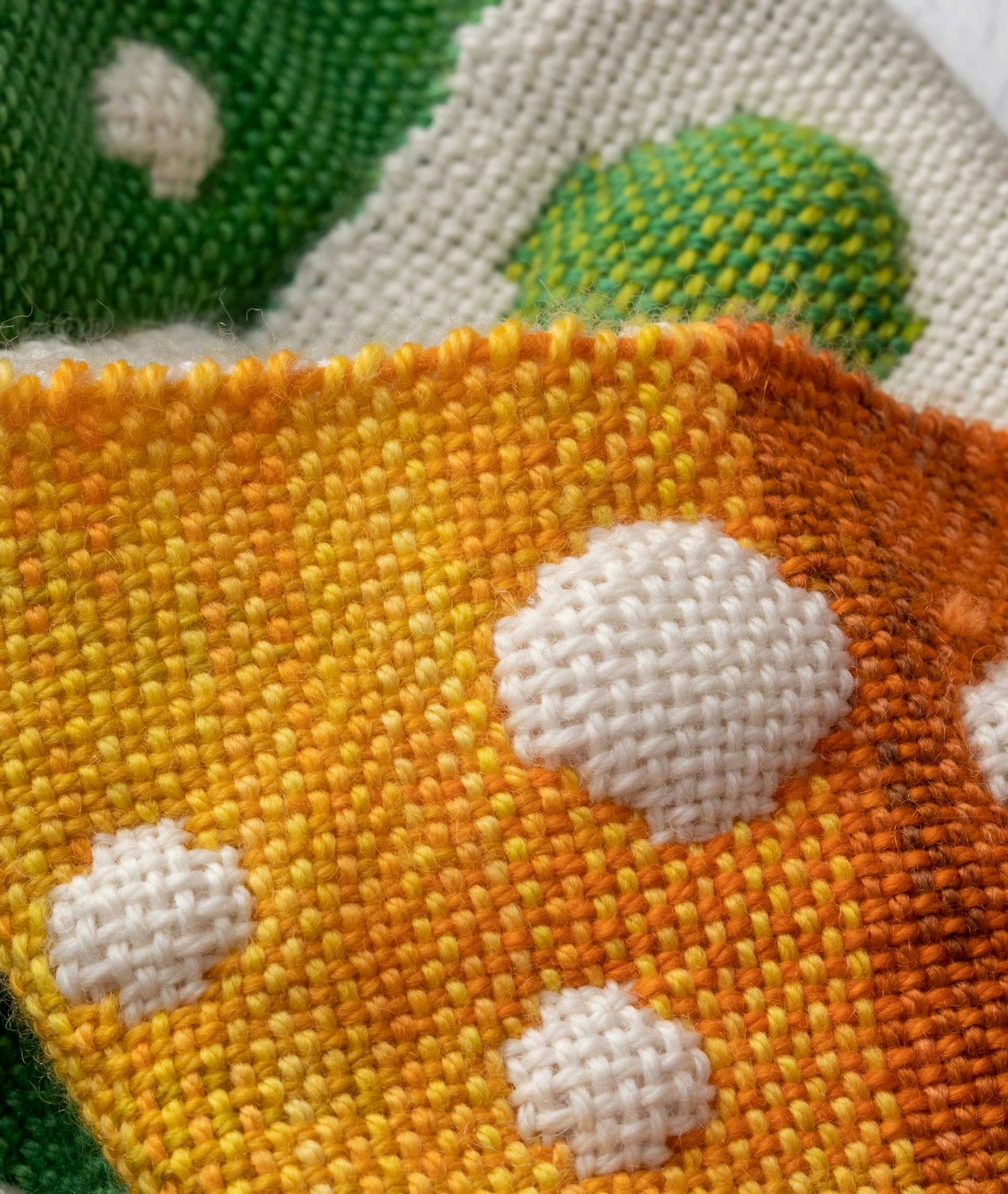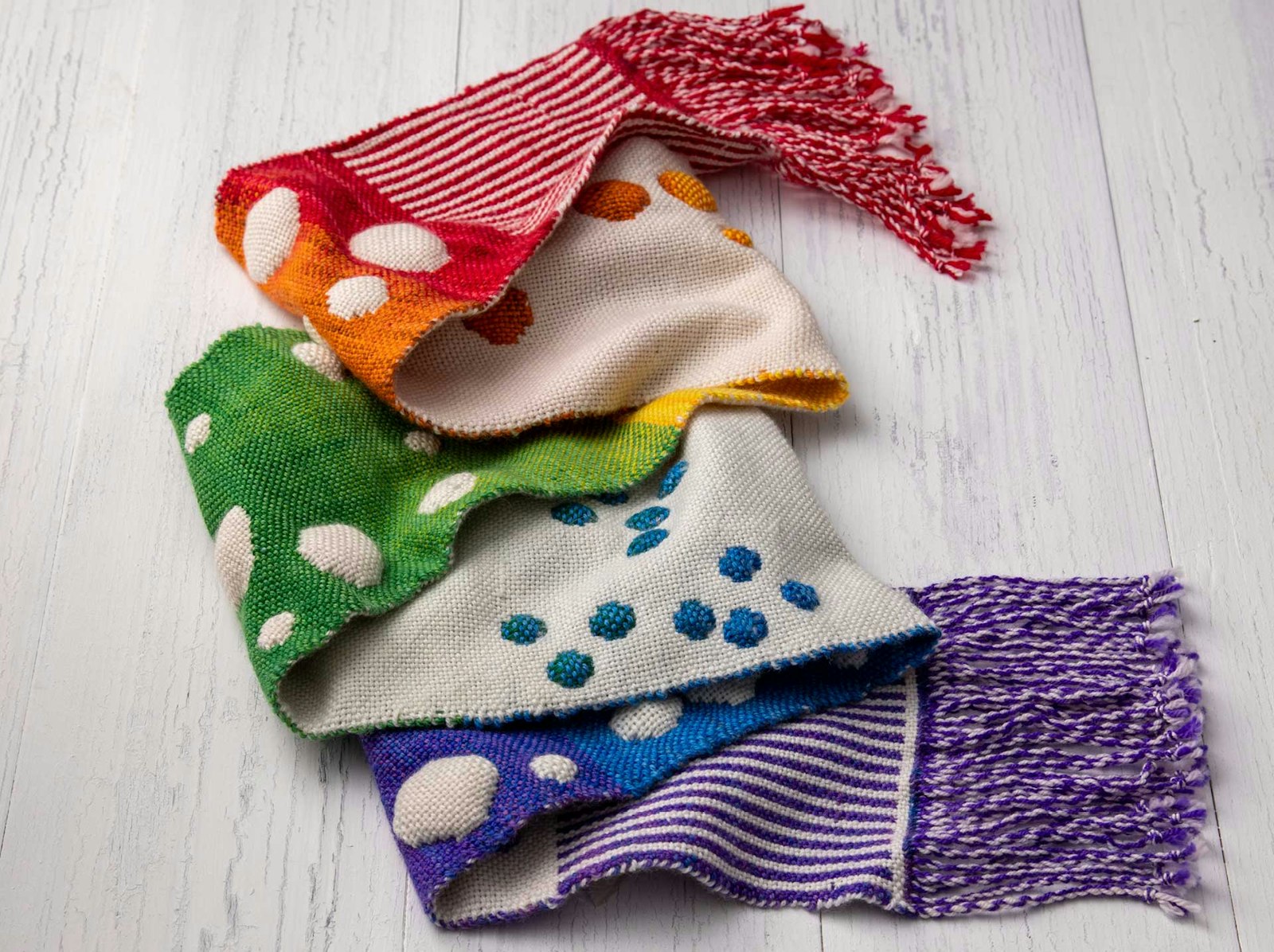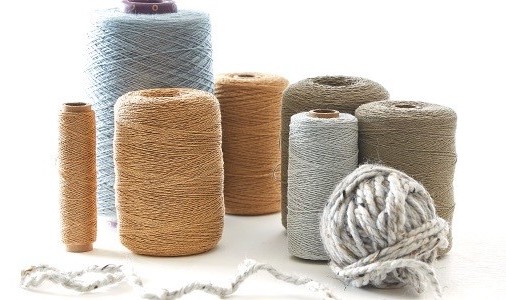Subscriber Exclusive
Idea Gallery: Double Knit to Doubleweave
Yvonne set herself the challenge of weaving a scarf that looks much like a knitted scarf that she loves. A link to her draft, pick-up instructions, and pick-up charts is included in this post.
While looking through Jennifer Moore’s Doubleweave: Revised and Expanded, I became fascinated by doubleweave pick-up, especially by how Jennifer used it to make circles. The design reminded me of Lucy Neatby’s double-knitting pattern Bubbles Scarf (see Resources). I set myself the challenge of transforming Lucy’s scarf into doubleweave. Before starting, I emailed Lucy and asked permission to use her design and received a prompt positive response.
Yarn
Lucy knitted her scarf with Kauni Wool 8/2 Effektgarn, which is great for subtly changing rainbow colors in knitting. However, in weaving, the color changes create long warp stripes that wouldn’t work for this project. I started looking for a handpainted warp with a gradation of colors but couldn’t find quite what I was looking for. It came to me that I could dye my own. I have a weakness for soft yarns, so I picked out my favorite blend of merino/cashmere/nylon (MCN) sock yarn (see Resources). The superwash merino makes up 80% of the yarn, but the 10% nylon keeps the yarn from being too stretchy, and the cashmere adds extra next-to-skin softness.
Warp
I based my calculations on a 60-inch finished scarf. Estimating 10 percent shrinkage meant I’d need a total of 66 inches of weavable warp on the loom. There were 11 sections in the original knitting diagram, so each section represented 6 inches of weaving. I needed two warps, one for the natural layer and one for the rainbow layer.
I chose 6 inches for a finished width and again allowed for 10 percent shrinkage, which meant I needed about 6 2/3 inches in the reed at a sett of 24 ends per inch, or 80 ends per layer. With calculations in hand, I measured out two warps of 80 ends each, one for each layer, adding 30 inches for loom waste and fringe for a total warp length of 96 inches. On one warp, I carefully marked with ties where the loom waste would be at the beginning and end of the warp while still under tension on the warping board. These lengths will change once tension is taken off the warp, so it is important to mark them beforehand. I soaked both warps in warm water to prepare them for dyeing. It’s essential to treat both warps the same way to avoid differential shrinkage later.
I laid the warp that was to be the rainbow layer out on a long table and evenly divided the center portion of the warp into six individual color sections. Using acid dyes, I started with red and following the color wheel, dyed each section in turn with orange, yellow, green, blue, and purple. I dyed the front loom waste in red and dyed the back loom waste purple. This way, if my calculations were off a little bit, it wouldn’t show in the final scarf.

Knitted scarf. Photos by Hillary Dionne.
Weft
Next, I dyed my weft yarns. The original knitting pattern had striking, bold colors and the only way to get pure colors like that in weaving is for the warp and weft to be the same color. To achieve those pops of bold color, I dyed a rainbow set of six 50-yard mini skeins for weft. I also soaked a 200-yard skein of natural weft as I had done for the natural warp.
While looking through Jennifer Moore’s Doubleweave: Revised and Expanded, I became fascinated by doubleweave pick-up, especially by how Jennifer used it to make circles. The design reminded me of Lucy Neatby’s double-knitting pattern Bubbles Scarf (see Resources). I set myself the challenge of transforming Lucy’s scarf into doubleweave. Before starting, I emailed Lucy and asked permission to use her design and received a prompt positive response.
Yarn
Lucy knitted her scarf with Kauni Wool 8/2 Effektgarn, which is great for subtly changing rainbow colors in knitting. However, in weaving, the color changes create long warp stripes that wouldn’t work for this project. I started looking for a handpainted warp with a gradation of colors but couldn’t find quite what I was looking for. It came to me that I could dye my own. I have a weakness for soft yarns, so I picked out my favorite blend of merino/cashmere/nylon (MCN) sock yarn (see Resources). The superwash merino makes up 80% of the yarn, but the 10% nylon keeps the yarn from being too stretchy, and the cashmere adds extra next-to-skin softness.
Warp
I based my calculations on a 60-inch finished scarf. Estimating 10 percent shrinkage meant I’d need a total of 66 inches of weavable warp on the loom. There were 11 sections in the original knitting diagram, so each section represented 6 inches of weaving. I needed two warps, one for the natural layer and one for the rainbow layer.
I chose 6 inches for a finished width and again allowed for 10 percent shrinkage, which meant I needed about 6 2/3 inches in the reed at a sett of 24 ends per inch, or 80 ends per layer. With calculations in hand, I measured out two warps of 80 ends each, one for each layer, adding 30 inches for loom waste and fringe for a total warp length of 96 inches. On one warp, I carefully marked with ties where the loom waste would be at the beginning and end of the warp while still under tension on the warping board. These lengths will change once tension is taken off the warp, so it is important to mark them beforehand. I soaked both warps in warm water to prepare them for dyeing. It’s essential to treat both warps the same way to avoid differential shrinkage later.
I laid the warp that was to be the rainbow layer out on a long table and evenly divided the center portion of the warp into six individual color sections. Using acid dyes, I started with red and following the color wheel, dyed each section in turn with orange, yellow, green, blue, and purple. I dyed the front loom waste in red and dyed the back loom waste purple. This way, if my calculations were off a little bit, it wouldn’t show in the final scarf.

Knitted scarf. Photos by Hillary Dionne.
Weft
Next, I dyed my weft yarns. The original knitting pattern had striking, bold colors and the only way to get pure colors like that in weaving is for the warp and weft to be the same color. To achieve those pops of bold color, I dyed a rainbow set of six 50-yard mini skeins for weft. I also soaked a 200-yard skein of natural weft as I had done for the natural warp.
[PAYWALL]
Setting up the Loom
For me, the easiest way to put two warps on a loom is warping front to back. First, I sleyed the rainbow warp with 1 end per dent. Then I did the same thing with the natural warp, sleying those ends with the rainbow ends. I threaded the heddles as usual and wound the warp onto the warp beam.
Charts
Knitted stitches are wider than they are tall, and a good knitting chart will accommodate for this. Because my goal was a balanced sett for each layer, I adjusted the original bubble charts to be round and not oval. In the spirit of transforming the original pattern, I chose to use Lucy’s diagram for placement. I created a chart for each section: 40 squares wide (two rainbow and two natural ends in the warp) and 36 squares tall. (A sett of 24 at 6 inches equals 144 picks or 36 sets of the 4-pick doubleweave sequence.) I made my charts in color and added in white bubbles so that I was working on the rainbow side as I wove. Editor’s note: Pick-up charts, drafts, and pick-up instructions for the scarf are available as a free PDF download at handwovenmagazine.com/bubble-scarf-nd21.
Weaving
I worked with two shuttles at a time, one natural and one colored, changing to the next weft color whenever I felt like the warp color had changed. It didn’t matter exactly where the change happened because the colors blended in the warp making transitional colors. For example, when I saw that the green section of warp was changing to blue, I switched my weft to blue.
I started with a couple of plain-weave picks, then hemstitched.
Next, I moved on to the “ribbing” using the pick-up treadling and following the chart. The 1 × 1 pattern is slow, but I hadn’t woven doubleweave pick-up before, so this gave me some practice. By the time I was through, I felt like a pro! Weaving the bubbles was easier and much more fun. After the ribbing, I followed the charts, weaving rows with and without bubbles and using highlighter tape on the charts to keep track of my work. I found that some of the pick-up sheds were narrow and followed Jennifer Moore’s advice to use a wide pick-up stick to open them up with great success.

Woven scarf. Photo by Matt Graves.
Stuffing the Bubbles
Lucy’s original pattern recommends stuffing the bubbles for a more three-dimensional appearance. After the last pick of a bubble, I would treadle to separate the layers and stuff the bubble lightly with cotton. The smallest bubbles were the trickiest and used the tiniest amount of stuffing. The next pick in the pattern sealed the bubbles with the stuffing inside.
Finishing
I finished with ribbing, and after having woven so much doubleweave pick-up, the second time was much easier. I flew through it! I finished with the same hemstitching as at the beginning.
With the fabric off the loom, I ironed the fringe and then trimmed it before twisting fringe with two ends from each layer in each bundle. I soaked the scarf in warm water for 10 to 20 minutes, rolled it in a towel, and then hung it to dry. The yarn bloomed subtly, making the scarf extra soft and cozy.
Overall, I enjoyed weaving this scarf. I learned so much through the whole process, and I now have many ideas for dyeing and doubleweave pick-up. Don’t be surprised if you see more patterns in the future!
Resources
Yvonne Ellsworth lives in Duvall, Washington, where she dyes yarn as LavenderSheep and teaches weaving classes locally. She is the social media coordinator for the Seattle Weavers’ Guild.




